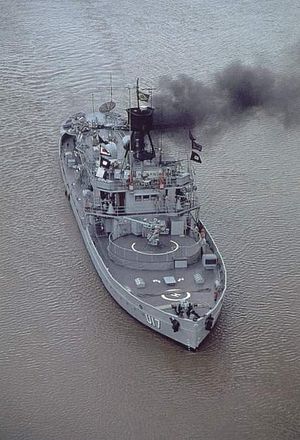Brazilian monitor Parnaíba (U17)
 |
|
| History | |
|---|---|
|
|
|
| Name: | Parnaíba |
| Builder: | Arsenal de Marinha do Rio de Janeiro |
| Laid down: | 11 June 1936 |
| Launched: | 2 September 1937 |
| Commissioned: | 9 March 1938 |
| Homeport: | Rio de Janeiro |
| Status: | in active service |
| General characteristics | |
| Type: | River monitor |
| Displacement: |
|
| Length: | 55 m (180.4 ft) |
| Beam: | 10.1 m (33.1 ft) |
| Draught: | 1.6 m (5.2 ft) |
| Propulsion: |
|
| Speed: | 12 knots (22 km/h) |
| Range: | 1,350 mi (1,170 nmi; 2,170 km) (2500 km) 10 knots (19 km/h) |
| Endurance: |
|
| Complement: | 74 |
| Armament: |
|
| Aviation facilities: | Helipad |
Parnaíba (U-17) is a river monitor of the Brazilian Navy.
She was built for the navy in Rio de Janeiro and commissioned on 9 March 1938. She participated in the Second World War and is currently the world's oldest commissioned warship still in active service. She is assigned to the Mato Grosso Flotilla.
She underwent a modernization program at the Ladario Riverine Naval Base between January 1998 and 6 May 1999, which saw the replacement of her original reciprocating engine plant with diesel engines to increase her range and endurance. (One of her original engines was placed on display at the Sixth Naval District's Lieutenant Maximiano Memorial Hall.) A helicopter platform has been fitted over the fantail, allowing her to operate the IH-6B Bell Jet Ranger III, replacing the UH-12 Squirrel Helibrás Monoturbina.
...
Wikipedia
